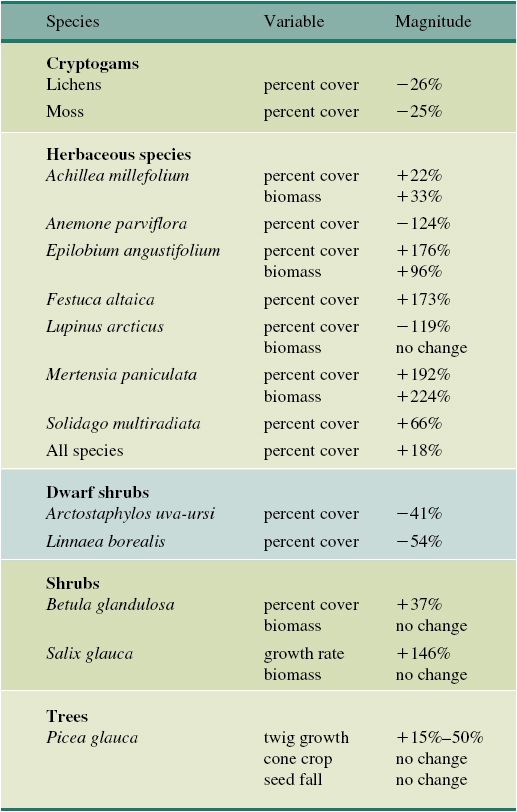 |
| Previous Image | Next Image |
| Description: You may recall from chapter 14 that a large number of Canadian researchers conducted a large-scale experiment manipulating resources, prey, and predators in an attempt to understand the linkages between plants, hares, and lynx in the Yukon. As part of this study, Roy Turkington, of the University of British Columbia, along with researchers from the University of Alberta, Nova Scotia Agricultural College, University of Toronto, and University of Sussex analyzed the response of the boreal vegetation to long-term nutrient additions (Turkington et al. 1998). The research team added fertilizer to two large (1 km2) plots, and monitored plant growth in these, and two control plots, for six years. Fertilizer was added each year, always including nitrogen, and in some years P and K were also added. The response they found varied more than what we saw on Kuparuk Ridge. One of the great strengths of the Turkington study is that they did not simply measure total production in the plots, but instead measured each of the major plant groups separately. By doing this, they found a rather interesting story (fig. 19.6). Overall, the biomass of the system increased, indicating soil fertility did in fact limit primary production. However, the exact effects of adding nutrients varied among the different plant types. The fast growing herbaceous species responded very quickly, while effects on tree growth only became apparent later in the study. Additionally, several plant species actually showed a reduction in growth due to fertilization. How is this possible if the boreal forest is nutrient limited? The answer is very straightforward: not all plants are equally limited by nutrients, and instead there exists a set of species that have life-histories adapted to stress tolerance (chapter 9). Under low nutrient conditions these plants will do just fine. However, by adding nutrients, the stress has been removed, and now the faster growing and more competitively dominant species are able to take over. In other words, even though an ecosystem may be nutrient limited, this does not mean that all species increase in growth if nutrients are added. This is a critical point to understand about ecosystem ecology. The factors that limit NPP, or other ecosystem processes, do not necessarily limit the growth of all species within the ecosystem.
Picture Stats: Views: 1104 Filesize: 206.17kB Height: 812 Width: 517 Source: https://biology-forums.com/index.php?action=gallery;sa=view;id=2026 |
